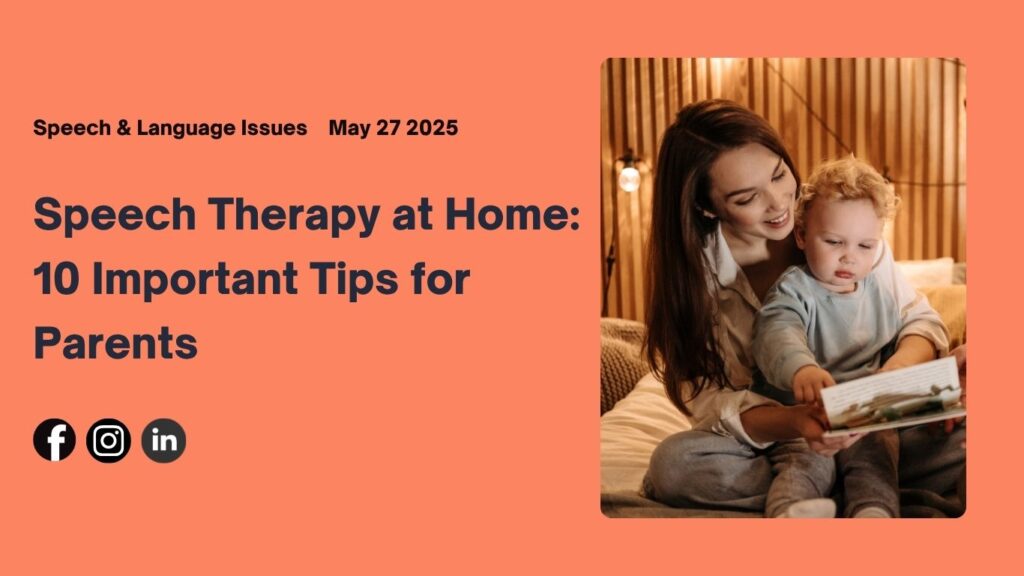
Speech therapy at home plays a vital role in your child’s communication journey. At Neuronurture Kids, we believe that speech therapy is not just a clinic-based process—it’s a journey that continues in your child’s daily routines and through your active involvement as a parent.
If your child is enrolled in speech therapy services, or you’re exploring ways to support their communication at home, this guide is for you. These 10 parent-friendly tips will help you integrate speech therapy into everyday life and boost your child’s language development.
1. Use Clear and Simple Language
Using clear, age-appropriate language is a key component of successful speech therapy at home. Speak slowly and use short sentences that your child can understand and imitate.
For example:
“Get the ball” instead of “Can you please go and bring me the ball from the toy box?”
This approach makes speech therapy at home more effective and reduces frustration during communication.
This approach makes speech therapy more effective and reduces frustration during communication.
2. Make Speech Therapy Part of Everyday Routines
Speech therapy doesn’t need to be a separate session—it works best when woven into daily activities. Whether you’re getting dressed, preparing meals, or going for a walk, every moment is a chance to practice language.
Describe what you’re doing:
“We are cutting an apple.”
“Put shoes on feet.”
Using everyday experiences makes speech therapy practical and easy to reinforce.
3. Encourage Imitation
Imitation is one of the foundational strategies in speech therapy. Encourage your child to copy the sounds, words, and actions you use.
Start with easy sounds or animal noises:
“Moo,” “Woof,” “Bye-bye,” “More”
This technique, commonly used by speech therapy professionals, helps children build confidence with basic communication.
4. Keep Repeating Words and Phrases
Repetition is essential in speech therapy. Children need to hear and practice words multiple times before using them independently.
You can say:
“Car. Red car. Car is fast.”
Repeating target words throughout the day helps your child retain and reproduce language naturally as part of speech therapy at home.
5. Use Visual Aids and Gestures
Many speech therapy techniques include visual support like flashcards, pictures, or gestures to help children understand and express words more easily.
Use visuals for:
- Emotions (happy, sad, angry)
- Objects (apple, bus, shoe)
- Actions (eat, sleep, run)
Visual cues make speech therapy more engaging and accessible for young learners or nonverbal children.
6. Give Your Child Choices
Speech therapy emphasizes the importance of giving children opportunities to express preferences. Offering choices helps children learn vocabulary and sentence structure.
Ask:
“Do you want milk or juice?”
“Shall we read a book or play a game?”
These small interactions build communication skills and strengthen your speech therapy routine.
7. Make It Fun and Play-Based
Children learn best through play, and play-based speech therapy keeps them motivated. Use toys, role-play, puzzles, and music to keep sessions enjoyable.
Ideas for home-based speech therapy games:
- Pretend cooking with food words
- Car races with action words like “go,” “stop,” and “turn”
- Hide-and-seek with object names
The more fun speech therapy is, the more your child will want to participate.
8. Read, Sing, and Talk Aloud
Reading books aloud and singing rhymes are highly recommended speech therapy strategies. These activities support listening, vocabulary, rhythm, and memory.
Try:
- Repetitive books with predictable endings
- Rhymes like “Twinkle Twinkle” or “Old MacDonald”
- Describing pictures in a book
Adding music and stories makes speech therapy enjoyable while reinforcing speech patterns.
9. Be Patient and Supportive
Progress in speech therapy takes time, and every child moves at their own pace. Celebrate small milestones, and avoid putting pressure on perfect pronunciation or grammar.
When your child says a word incorrectly, model the right version gently:
Child: “Tuh!”
Parent: “Cup! Yes, you want the cup!”
Positive reinforcement is a core value in home-based speech therapy.
10. Stay Connected with Your Speech Therapist
Your child’s speech therapy progress will be most effective when you stay in regular contact with your child’s speech-language pathologist (SLP).
Ask questions like:
- What should we focus on this week at home?
- Are there games or books you recommend?
- Is there anything we should avoid?
A collaborative approach ensures that home-based speech therapy aligns with clinic goals and supports your child’s unique needs.
Empower Your Child Through Everyday Speech Therapy
At Neuronurture Kids, we know that speech therapy works best when parents are engaged and confident. You don’t need to be an expert—just being consistent, supportive, and playful can significantly enhance your child’s communication journey.
These 10 home-based speech therapy tips will help you create a nurturing environment where your child can thrive—one word at a time.
Need Guidance? We’re Here to Help
If you’d like professional support or a personalized speech therapy plan for your child, our experienced team at Neuronurture Kids is just a call away.
Book a Free Parent Consultation Today
Let’s work together to help your child find their voice through effective, joyful, and consistent speech therapy at home.
i want to know more